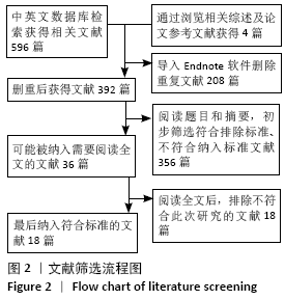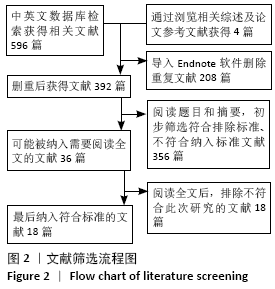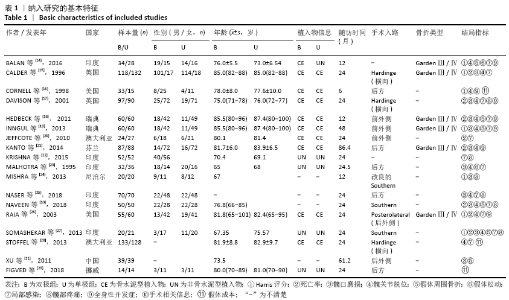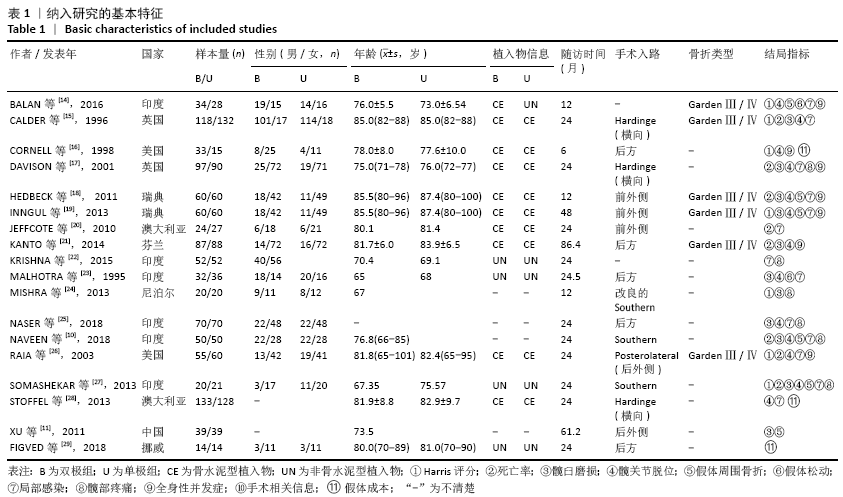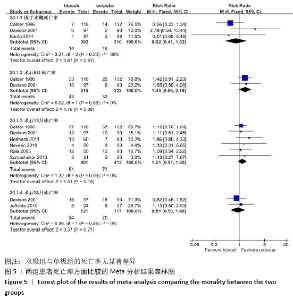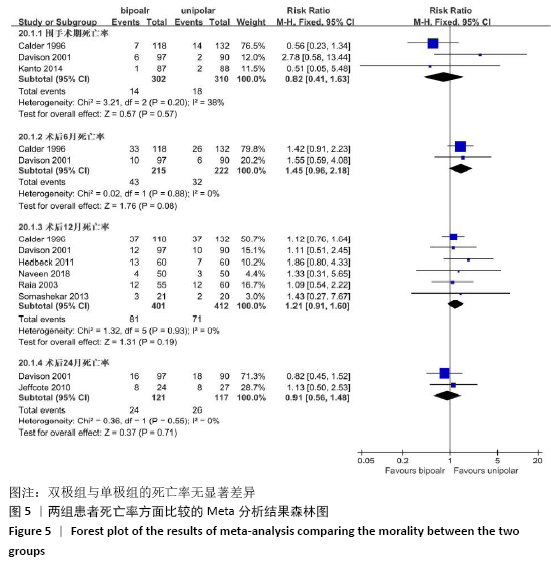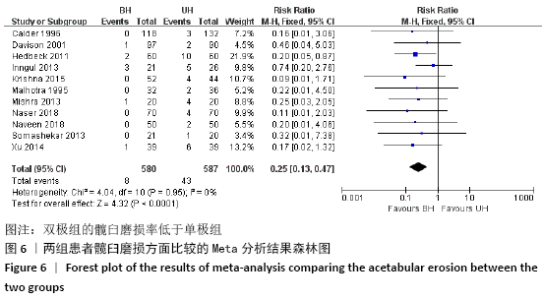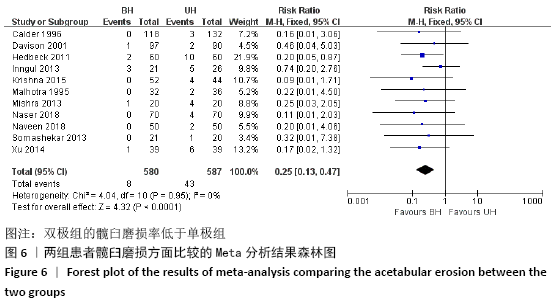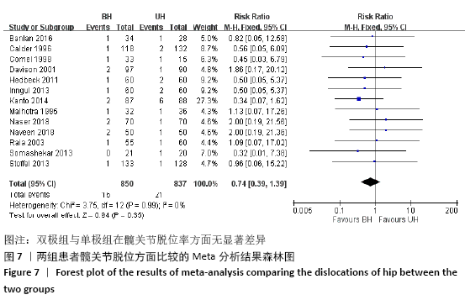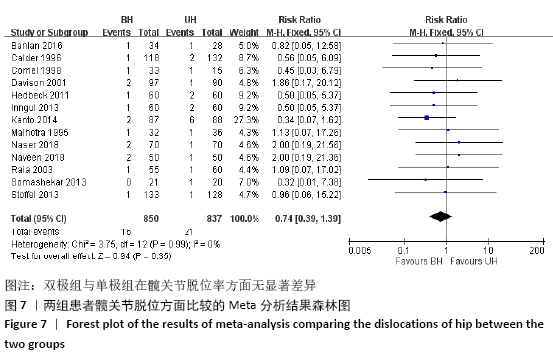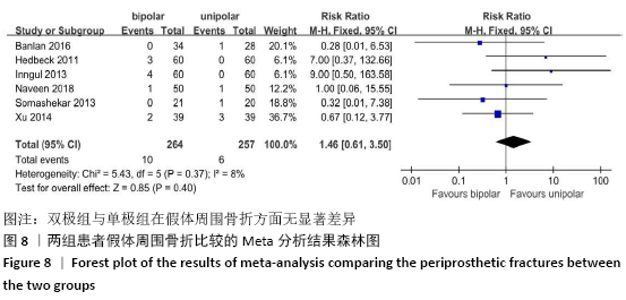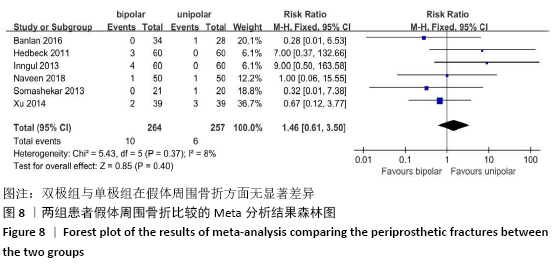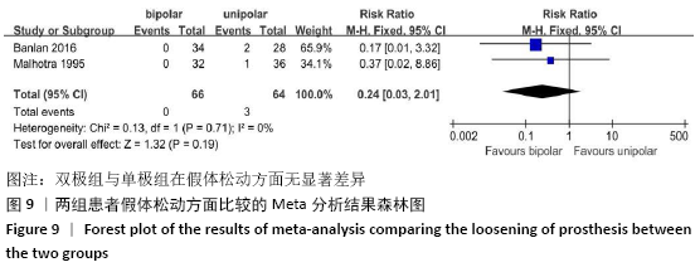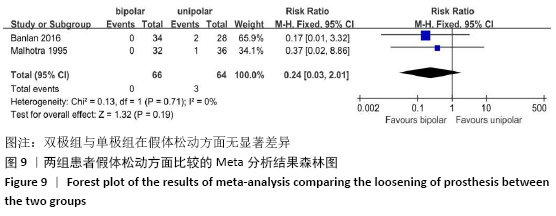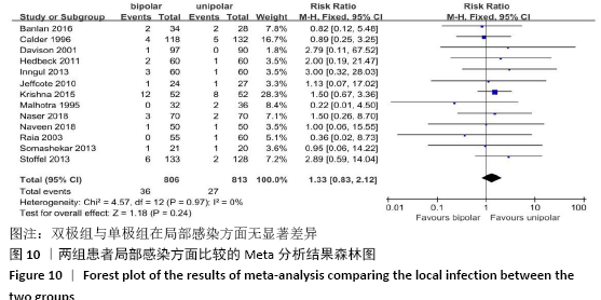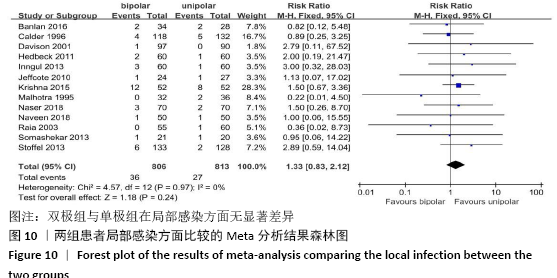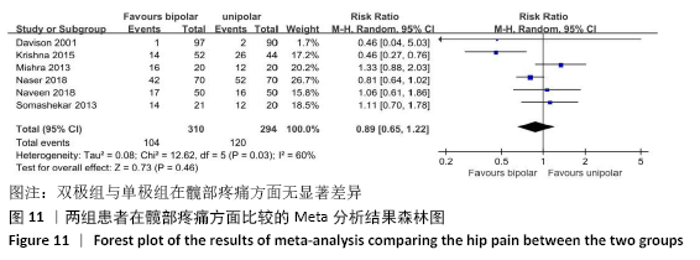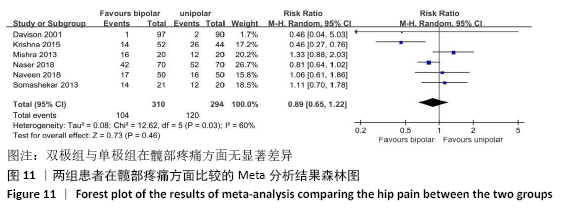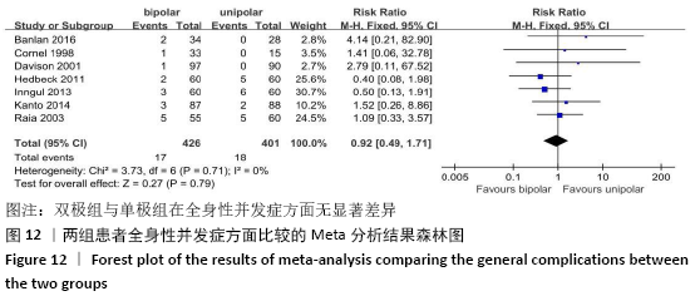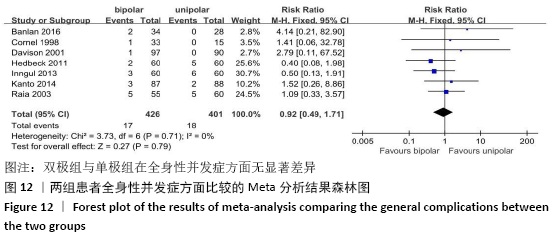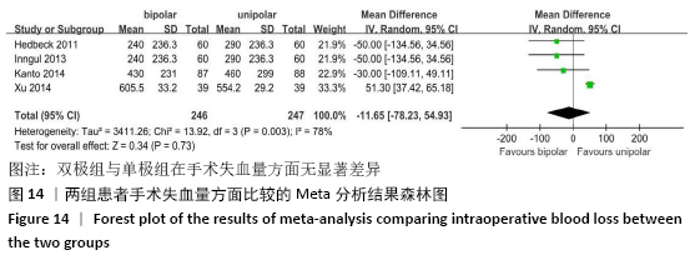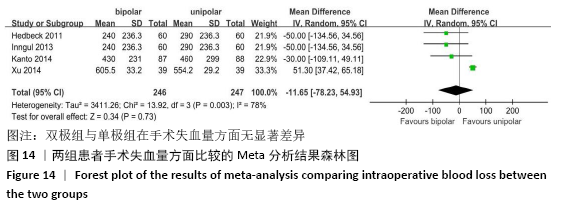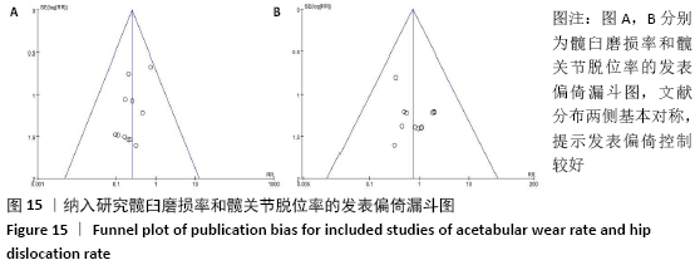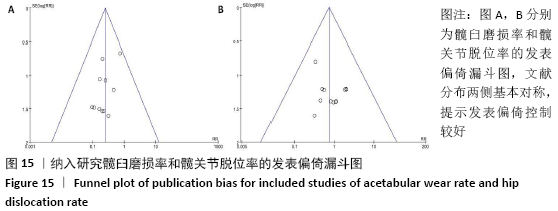Chinese Journal of Tissue Engineering Research ›› 2021, Vol. 25 ›› Issue (18): 2915-2922.doi: 10.3969/j.issn.2095-4344.3847
Previous Articles Next Articles
Meta-analysis of bipolar and unipolar hemiarthroplasties for displaced femoral neck fracture in the elderly patients
Yuan Jiaqin, Luan Fujun, Chen Yangfan, Deng Yi, Li Bo
- Department of Orthopedics, Yongchuan Hospital of Chongqing Medical University, Chongqing 402160, China
-
Received:2020-07-10Revised:2020-07-11Accepted:2020-08-13Online:2021-06-28Published:2021-01-12 -
Contact:Li Bo, Master, Chief physician, Department of Orthopedics, Yongchuan Hospital of Chongqing Medical University, Chongqing 402160, China -
About author:Yuan Jiaqin, Master candidate, Physician, Department of Orthopedics, Yongchuan Hospital of Chongqing Medical University, Chongqing 402160, China -
Supported by:the Natural Science Foundation of Yongchuan District, No. Ycstc, 2015nc5006 (to LFJ), No. Ycstc, 2018nb0201 (to DY)
CLC Number:
Cite this article
Yuan Jiaqin, Luan Fujun, Chen Yangfan, Deng Yi, Li Bo. Meta-analysis of bipolar and unipolar hemiarthroplasties for displaced femoral neck fracture in the elderly patients[J]. Chinese Journal of Tissue Engineering Research, 2021, 25(18): 2915-2922.
share this article
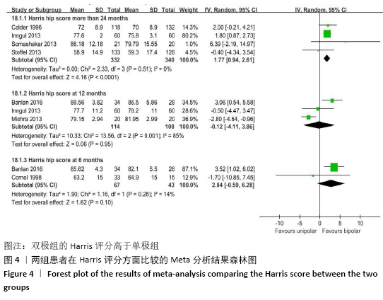
2.3 Meta分析结果 2.3.1 各组髋关节Harris评分比较 共纳入7个研究[14-16,19,24,27-28]。各研究结果间异质性较高(I2 > 50%),用逐一剔除的方法对其进行敏感性分析,提示结果较稳定。通过阅读全文,分析其异质性可能来源于随访时间的不同,随访时间的长短可能Harris评分有一定的影响,故采用随机效应模型合并效应量。亚组分析结果显示,单级组和双极组术后6,12个月的Harris评分差异无显著性意义(MD=2.84,95%CI:-0.59-6.28,P=0.10;MD=-0.12,95%CI: -4.11-3.86,P=0.95);术后24个月双极组的Harris评分明显高于单极组(MD=1.77,95%CI:0.94-2.61,P < 0.000 1),见图4。 "
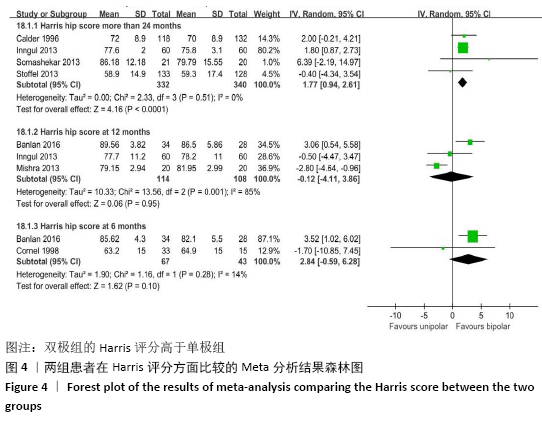
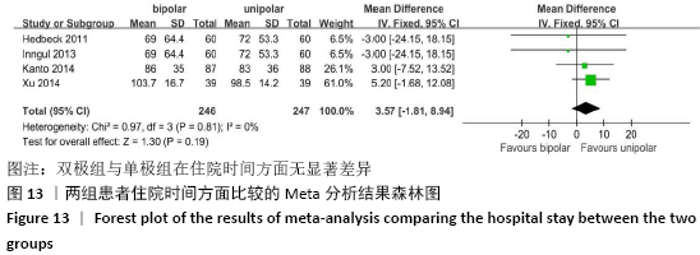
2.3.10 各组手术相关信息指标比较 手术相关信息包括手术时间、术中失血量以及住院时间。有4个研究评估了手术时间[11,18-19,21],由于研究组间不存在异质性(I2=0%),故采用固定效应模型合并效应量;有4个研究评估了术中失血量[11,18-19,21],各研究结果间异质性较高 (I2 > 50%),通过逐一剔除的方法对纳入文献进行敏感性分析提示结果较稳定,分析其异质性原因可能是因为主刀医师对手术方式的熟练程度不同所致,故采用随机效应模型合并效应量。Meta结果显示,两组在手术时间及术中失血量差异均无显著性意义(MD=3.57,95%CI: -1.81-8.94,P=0.19;MD=-11.65,95%CI:-78.23-54.93,P=0.73),结果见图13,14。有6个研究评估了住院时 间[15-17,24,26,28]。但其中5篇未显示标准差(SD) [15-17,24,26],因此无法进行Meta分析,而进行描述性的系统评价。所有报道住院时间的研究均表明,双极组与单极组住院时间无显著差异。"
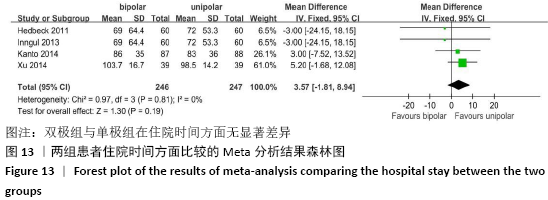
| [1] BOONEN S, SINGER AJ. Osteoporosis management: impact of fracture type on cost and quality of life in patients at risk for fracture I. Curr Med Res Opin. 2008;24(6):1781-1788. [2] STERLING RS. Gender and race/ethnicity differences in hip fracture incidence, morbidity, mortality, and function. Clin Orthop Relat Res. 2011;469(7):1913-1918. [3] FAJAR JK, TAUFAN T, SYARIF M, et al. Hip geometry and femoral neck fractures: a meta-analysis. J Orthop Translat. 2018;13:1-6. [4] LÖNNROOS E, KAUTIAINEN H, KARPPI P, et al. Increased incidence of hip fractures. A population based-study in Finland. Bone. 2006;39(3):623-627. [5] LUTNICK E, KANG J, FRECCERO DM. Surgical treatment of femoral neck fractures: a brief review. Geriatrics (Basel). 2020;5(2):E22. [6] MIGLIORINI F, TRIVELLAS A, DRIESSEN A, et al. Hemiarthroplasty versus total arthroplasty for displaced femoral neck fractures in the elderly: meta-analysis of randomized clinical trials. Arch Orthop Trauma Surg. 2020. doi: 10.1007/s00402-020-03409-3. [7] CROSSMAN PT, KHAN RJ, MACDOWELL A, et al. A survey of the treatment of displaced intracapsular femoral neck fractures in the UK. Injury. 2002;33(5):383-386. [8] IORIO R, SCHWARTZ B, MACAULAY W, et al. Surgical treatment of displaced femoral neck fractures in the elderly: a survey of the American Association of Hip and Knee Surgeons. J Arthroplasty. 2006;21(8): 1124-1133. [9] GUYEN O. Hemiarthroplasty or total hip arthroplasty in recent femoral neck fractures? Orthop Traumatol Surg Res. 2019;105(1S):S95-S101. [10] NAVEEN PR, KIRAN KUMAR HG, CHATANYA PR, et al. Prospective randomised control study of bipolar versus unipolar prosthesis in the management of fracture neck of femur in elderly patients. Int J Orth Sci. 2018;4(2):501-504. [11] 胥德政,任百芳.全髋关节与单双极人工股骨头置换治疗老年股骨颈骨折的疗效比较[J].中国骨与关节损伤杂志, 2011,26(6):522-523. [12] ALTMAN DG, BLAND JM. Standard deviations and standard errors. BMJ. 2005; 331(7521):903. [13] HIGGINS J, GREEN S. Cochrane Handbook for Systematic Reviews of Interventions Version 5.1.0. The Cochrane Collaboration2011[2012-03-30]. Available from: http://www.cochrane-handbook.org./. [14] BALAN B, SHETTY SK, SHETTY A, et al. Displaced intra-capsular neck femur fractures in elderly: Austin Moore’s prosthesis or cemented modular bipolar prosthesis. IAIM. 2016;3(7):287-296. [15] CALDER SJ, ANDERSON GH, JAGGER C, et al. Unipolar or bipolar prosthesis for displaced intracap-sular hip fracture in octogenarians: a randomised prospective study. J Bone Joint Surg Br. 1996;78(3):391-394. [16] CORNELL CN, LEVINE D, O’DOHERTY J, et al. Unipolar versus bipolar hemiarthroplasty for the treatment of femoral neck fractures in the elderly. Clin Orthop Relat Res. 1998; (348):67-71. [17] DAVISON JN, CALDER SJ, ANDERSON GH, et al. Treatment for displaced intracapsular fracture of the proximal femur: a prospective, randomised trial in patients aged 65 to 79 years. J Bone Joint Surg Br. 2001;83(2):206-212. [18] HEDBECK CJ, BLOMFELDT R, LAPIDUS G, et al. Unipolar hemiarthroplasty versus bipolar hemiar-throplasty in the most elderly patients with displaced femoral neck fractures: a randomised, controlled trial. Int Orthop. 2011;35(11):1703-1711. [19] INNGUL C, HEDBECK CJ, BLOMFELDT R, et al. Unipolar hemiarthroplasty versus bipolar hemiar-throplasty in patients with displaced femoral neck fractures: a four-year follow-up of a randomised con-trolled trial. Int Orthop. 2013;37(12):2457-2464. [20] JEFFCOTE B, LI MG, BARNET-MOORCROFT A, et al. Roentgen stereophotogrammetric analysis and clinical assessment of unipolar versus bipolar hemiarthroplasty for subcapital femur fracture: a randomized prospective study. ANZ J Surg. 2010;80(4): 242-246. [21] KANTO K, SIHVONEN R, ESKELINEN A, et al. Uni- and bipolar hemiarthroplasty with a modern cemented femoral component provides elderly patients with displaced femoral neck fractures with equal functional outcome and survivorship at medium-term follow-up. Arch Orthop Trauma Surg. 2014;134(9):1251-1259. [22] KRISHNA KS, RAO DV, REDDY GR, et al. Comparative study between Austin moore prosthesis and bipolar prosthesis in fracture neck of femur. Evolution of Medical and Dental Sciences. 2015;4(101):16605-16610. [23] MALHOTRA R, ARYA R, BHAN S. Bipolar hemiarthroplasty in femoral neck fractures. Arch Orthop Trauma Surg. 1995;114(2):79-82. [24] MISHRA AK, CHALISE PK, SHAH SB, et al. Comparative study in surgical outcome of intracapsular fracture neck of femur in active elderly patients treated with hemiarthroplasty with Austin Moore’s and bipolar prosthesis. Nepal Med Coll J. 2013;15(1):81-83. [25] NASER MA, PATHAK R, AHMAD A. Superiority of fixed stem bipolar prosthesis over Austin Moore prosthetic in fracture neck femur. Int J Res Orthop. 2018;4(4):577-581. [26] RAIA FJ, CHAPMAN CB, HERRERA MF, et al. Unipolar or bipolar hemiarthroplasty for femoral neck fractures in the elderly? Clin Orthop Relat Res. 2003;(414):259-265. [27] SOMASHEKAR, KRISHNA SV, SRIDHARA MURTHY J. Treatment of femoral neck fractures: unipo-lar versus bipolar hemiarthroplasty. Malays Orthop J. 2013; 7(2):6-11. [28] STOFFEL KK, NIVBRANT B, HEADFORD J, et al. Does a bipolar hemiprosthesis offer advantages for elderly patients with neck of femur fracture? A clinical trial with 261 patients. ANZ J Surg. 2013;83(4):249-254. [29] FIGVED W, SVENØY S, RÖHRL SM, et al. Higher cartilage wear in unipolar than bipolar hemiarthro-plasties of the hip at 2 years: a randomized controlled radiostereometric study in 19 fit elderly patients with femoral neck fractures. Acta Orthop. 2018;89(5):503-508. [30] 陈卫.国际视野下的中国人口老龄化[J].北京大学学报(哲学社会科学版), 2016,53(6):82-92. [31] FRIHAGEN F, NORDSLETTEN L, MADSEN JE. Hemiarthroplasty or internal fixation for intracapsular displaced femoral neck fractures: randomised controlled trial. BMJ. 2007;335(7632):1251-1254. [32] 吴新宝,杨明辉.老年髋部骨折诊疗专家共识(2017)[J].中华创伤骨科杂志, 2017,19(11):921-927. [33] 杨飞,胡黎婷,张兴胜.三种术式治疗老年移位股骨颈骨折临床疗效对比研究[J].中国矫形外科杂志,2019,27(20): 1850-1855. [34] BARIŞHAN FC, AKESEN B, ATICI T, et al. Comparison of hemiarthroplasty and total hip arthroplasty in elderly patients with displaced femoral neck fractures. J Int Med Res. 2018;46(7):2717-2730. [35] 衣效坤,颜冰.人工髋关节置换术治疗老年股骨颈骨折的研究进展[J].世界最新医学信息文摘,2019,19(82):121-125. [36] ABDELKHALEK M, ABDELWAHAB M, ALI AM. Bipolar versus fixed-head hip arthroplasty for fem-oral neck fractures in elderly patients. Strategies Trauma Limb Reconstr. 2011;6(1):1-6. [37] BHATTACHARYYA T, KOVAL KJ. Unipolar versus bipolar hemiarthroplasty for femoral neck fractures: is there a difference? J Orthop Trauma. 2009;23(6):426-427. [38] AVERY PP, BAKER RP, WALTON MJ, et al. Total hip replacement and hemiarthroplasty in mobile, independent patients with a displaced intracapsular fracture of the femoral neck: a seven- to ten-year fol-low-up report of a prospective randomised controlled trial. J Bone Joint Surg Br. 2011; 93(8):1045-1048. [39] ZHOU Z, YAN F, SHA W, et al. Unipolar versus bipolar hemiarthroplasty for displaced femoral neck fractures in elderly patients. Orthopedics. 2015;38(11):697-702. [40] LIU Y, TAO X, WANG P, et al. Meta-analysis of randomised controlled trials comparing unipolar with bipolar hemiarthroplasty for displaced femoral-neck fractures. Int Orthop. 2014;38(8):1691-1696. [41] GROSSO MJ, DANOFF JR, MURTAUGH TS, et al. Hemiarthroplasty for Displaced Femoral Neck Fractures in the Elderly Has a Low Conversion Rate. J Arthroplasty. 2017;32(1):150-154. [42] VAN DEN BEKEROM MP, SIEREVELT IN, BONKE H, et al. The natural history of the hemiarthroplasty for displaced intracapsular femoral neck fractures. Acta Orthop. 2013; 84(6):555-560. [43] 李强,罗先正,王志义,等.人工髋关节置换术后评估方法的研究[J].中华骨科杂志,2001,21(12):16-20. [44] 金宝城,侯筱魁.双极人工股骨头置换术后中远期疗效分析[J].中国矫形外科杂志,1999,6(9):20-22. [45] SIMON P, GOUIN F, VEILLARD D, et al. Les fractures du col du fémur après 50 ans [Femoral neck fractures in patients over 50 years old]. Rev Chir Orthop Reparatrice Appar Mot. 2008;94 Suppl(6):S108-S132. |
| [1] | Hu Kai, Qiao Xiaohong, Zhang Yonghong, Wang Dong, Qin Sihe. Treatment of displaced intra-articular calcaneal fractures with cannulated screws and plates: a meta-analysis of 15 randomized controlled trials [J]. Chinese Journal of Tissue Engineering Research, 2021, 25(9): 1465-1470. |
| [2] | Huang Dengcheng, Wang Zhike, Cao Xuewei. Comparison of the short-term efficacy of extracorporeal shock wave therapy for middle-aged and elderly knee osteoarthritis: a meta-analysis [J]. Chinese Journal of Tissue Engineering Research, 2021, 25(9): 1471-1476. |
| [3] | Xu Feng, Kang Hui, Wei Tanjun, Xi Jintao. Biomechanical analysis of different fixation methods of pedicle screws for thoracolumbar fracture [J]. Chinese Journal of Tissue Engineering Research, 2021, 25(9): 1313-1317. |
| [4] | Jiang Yong, Luo Yi, Ding Yongli, Zhou Yong, Min Li, Tang Fan, Zhang Wenli, Duan Hong, Tu Chongqi. Von Mises stress on the influence of pelvic stability by precise sacral resection and clinical validation [J]. Chinese Journal of Tissue Engineering Research, 2021, 25(9): 1318-1323. |
| [5] | Zhang Tongtong, Wang Zhonghua, Wen Jie, Song Yuxin, Liu Lin. Application of three-dimensional printing model in surgical resection and reconstruction of cervical tumor [J]. Chinese Journal of Tissue Engineering Research, 2021, 25(9): 1335-1339. |
| [6] | Zhang Yu, Tian Shaoqi, Zeng Guobo, Hu Chuan. Risk factors for myocardial infarction following primary total joint arthroplasty [J]. Chinese Journal of Tissue Engineering Research, 2021, 25(9): 1340-1345. |
| [7] | Wei Wei, Li Jian, Huang Linhai, Lan Mindong, Lu Xianwei, Huang Shaodong. Factors affecting fall fear in the first movement of elderly patients after total knee or hip arthroplasty [J]. Chinese Journal of Tissue Engineering Research, 2021, 25(9): 1351-1355. |
| [8] | Wang Jinjun, Deng Zengfa, Liu Kang, He Zhiyong, Yu Xinping, Liang Jianji, Li Chen, Guo Zhouyang. Hemostatic effect and safety of intravenous drip of tranexamic acid combined with topical application of cocktail containing tranexamic acid in total knee arthroplasty [J]. Chinese Journal of Tissue Engineering Research, 2021, 25(9): 1356-1361. |
| [9] | Xiao Guoqing, Liu Xuanze, Yan Yuhao, Zhong Xihong. Influencing factors of knee flexion limitation after total knee arthroplasty with posterior stabilized prostheses [J]. Chinese Journal of Tissue Engineering Research, 2021, 25(9): 1362-1367. |
| [10] | Huang Zexiao, Yang Mei, Lin Shiwei, He Heyu. Correlation between the level of serum n-3 polyunsaturated fatty acids and quadriceps weakness in the early stage after total knee arthroplasty [J]. Chinese Journal of Tissue Engineering Research, 2021, 25(9): 1375-1380. |
| [11] | Zhang Chong, Liu Zhiang, Yao Shuaihui, Gao Junsheng, Jiang Yan, Zhang Lu. Safety and effectiveness of topical application of tranexamic acid to reduce drainage of elderly femoral neck fractures after total hip arthroplasty [J]. Chinese Journal of Tissue Engineering Research, 2021, 25(9): 1381-1386. |
| [12] | Wang Haiying, Lü Bing, Li Hui, Wang Shunyi. Posterior lumbar interbody fusion for degenerative lumbar spondylolisthesis: prediction of functional prognosis of patients based on spinopelvic parameters [J]. Chinese Journal of Tissue Engineering Research, 2021, 25(9): 1393-1397. |
| [13] | Lü Zhen, Bai Jinzhu. A prospective study on the application of staged lumbar motion chain rehabilitation based on McKenzie’s technique after lumbar percutaneous transforaminal endoscopic discectomy [J]. Chinese Journal of Tissue Engineering Research, 2021, 25(9): 1398-1403. |
| [14] | Chen Xinmin, Li Wenbiao, Xiong Kaikai, Xiong Xiaoyan, Zheng Liqin, Li Musheng, Zheng Yongze, Lin Ziling. Type A3.3 femoral intertrochanteric fracture with augmented proximal femoral nail anti-rotation in the elderly: finite element analysis of the optimal amount of bone cement [J]. Chinese Journal of Tissue Engineering Research, 2021, 25(9): 1404-1409. |
| [15] | Du Xiupeng, Yang Zhaohui. Effect of degree of initial deformity of impacted femoral neck fractures under 65 years of age on femoral neck shortening [J]. Chinese Journal of Tissue Engineering Research, 2021, 25(9): 1410-1416. |
| Viewed | ||||||
|
Full text |
|
|||||
|
Abstract |
|
|||||
